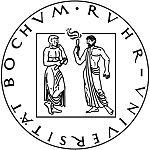Ruhr-Universität Bochum
| Ruhr-Universität Bochum | |
 |
|
| Motto | menschlich – weltoffen – leistungsstark (German) |
|---|---|
|
Motto in English
|
People-centred – Cosmopolitan – High-performance |
| Type | Public University |
| Established | 1962 |
| Endowment | €530 million (2013) |
| Chancellor | Christina Reinhardt |
| Rector | Axel Schölmerich |
|
Academic staff
|
Professor 411 Junior Professor 71 Academic Staff 2,745 |
|
Administrative staff
|
2,390 |
| Students | 43,004 |
| Undergraduates | 22,458 |
| Postgraduates | 9,814 |
| 3,619 | |
|
Other students
|
7,223 (International Students) |
| Location |
Bochum, North Rhine-Westphalia, Germany 51°26′38″N 7°15′42″E / 51.44389°N 7.26167°ECoordinates: 51°26′38″N 7°15′42″E / 51.44389°N 7.26167°E |
| Campus |
Urban/Suburban Campus area 4.5 sq.km |
| Nickname | RUB |
| Affiliations | UA Ruhr, DAAD, DFG, Utrecht Network, MAUI Network, AEN Network, NOHA Network |
| Website | www |
 |
|
Ruhr-University Bochum (German: Ruhr-Universität Bochum, RUB), located on the southern hills of central Ruhr area Bochum, was founded in 1962 as the first new public university in Germany since World War II. Instruction began in 1965.
The Ruhr-University Bochum is one of the largest universities in Germany and part of the Deutsche Forschungsgemeinschaft, the most important German research funding organization.
The RUB was very successful in the Excellence Initiative of the German Federal and State Governments (2007), a competition between Germany's most prestigious universities. It was one of the few institutions left competing for the title of an "elite university", but did not succeed in the last round of the competition. There are currently nine universities in Germany that hold this title.
The University of Bochum was one of the first universities in Germany to introduce international bachelor's and master's degrees, which replaced the traditional German Diplom and Magister. Except for a few special cases (for example in Law) these degrees are offered by all faculties of the Ruhr-University. Currently, the university offers a total of 184 different study programs from all academic fields represented at the university.
Ruhr-University is financed and administered by the state of North Rhine-Westphalia. Currently, 42,718 students are enrolled, and the university employs around 5,600 staff (411 of which are professors), making it one of the ten largest universities in Germany (as of 2014). Kurt Biedenkopf, who later became prime minister of the state of Saxony, was director of the university from 1967 to 1969.
The university is organized in twenty different faculties. These are:
English education
ECUE - European Culture and Economy
Interdisciplinary institutions
Unlike many older German universities, the buildings of Ruhr-University are all centralized on one campus, located south of Bochum city. The Faculty of Medicine includes several university clinics which are located at different centres in Bochum and the Ruhr area. A major facility for patient care is the University Hospital/Knappschaftskrankenhaus in the Langendreer part of Bochum. Internationally renowned experts in their respective fields are professors Wolff Schmiegel in oncology and Burkhard Dick in ophthalmology. The centralized university campus architecture is comprised almost exclusively of the 1960s architecture style referred to as Brutalism, consisting of 14 almost identical high-rise buildings. One striking feature of these buildings is that although their roofs are all at the same apparent height (sky level), the absolute heights of the buildings vary in accordance with their placement on the undulating landscape in which the university is located: the campus is at the edge of a green belt on high ground adjacent to the Ruhr valley.
...
Wikipedia
